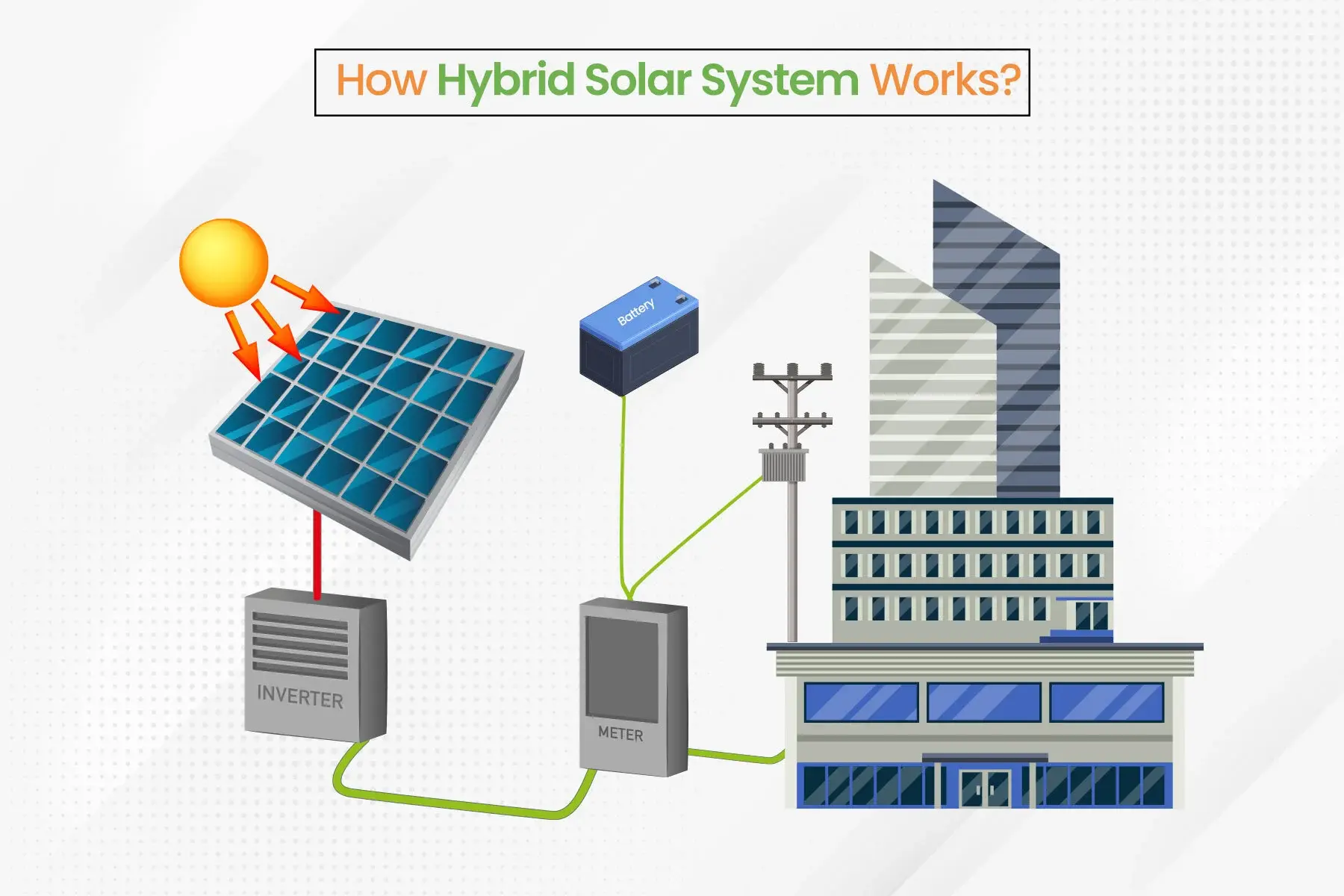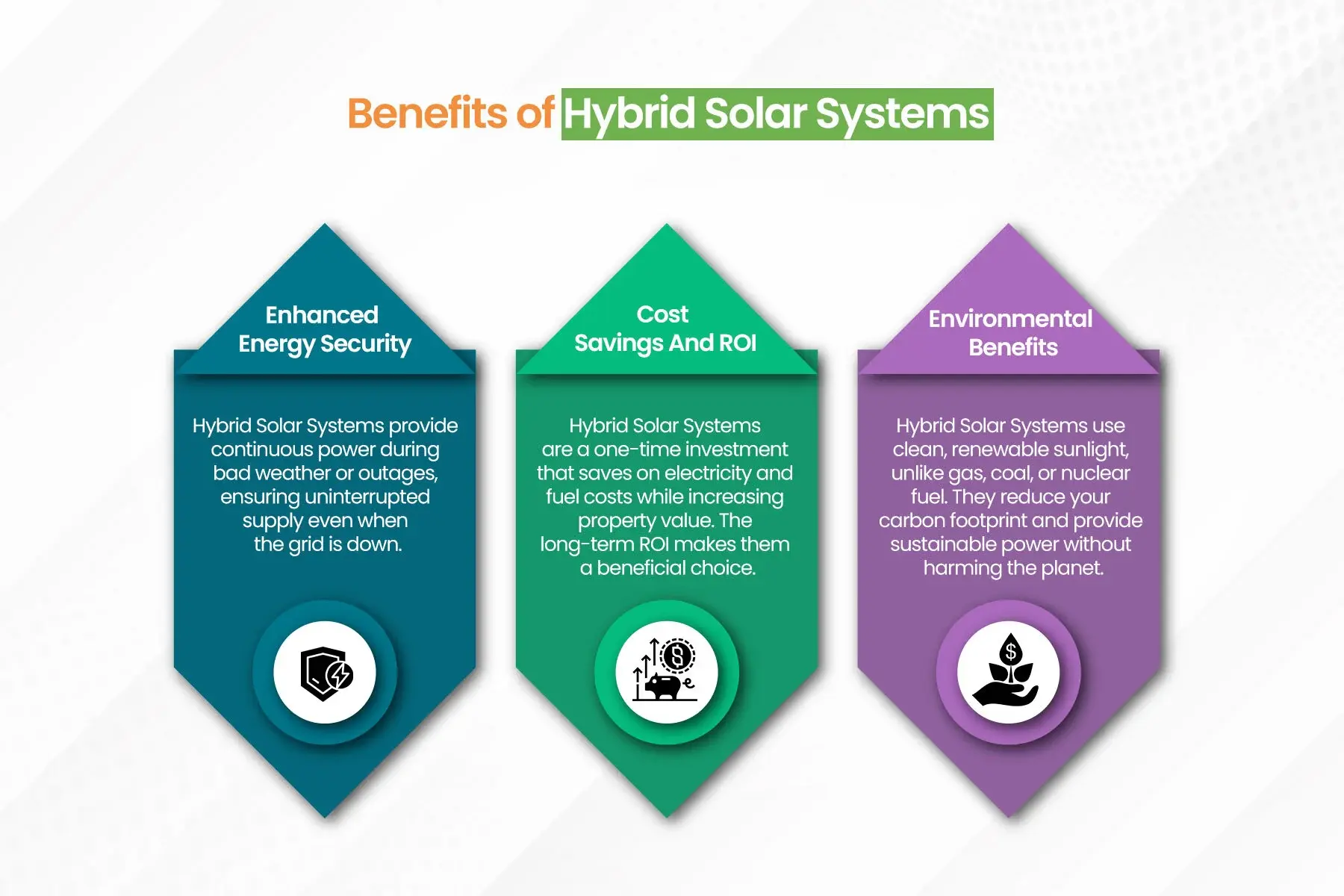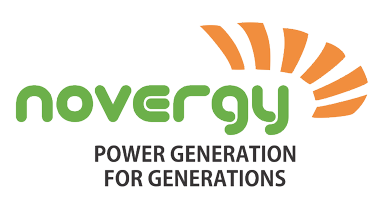In the Early 90s as technologies improved the attention was drawn more towards Hybrid Solar Systems. This period saw a rapid increase in the usage of combining solar with battery storage. In the past few years, the use of solar energy has increased as more people are aware of its environmental friendliness.
This Blog aims to provide a complete overview of the Hybrid Solar System, its Definition, How it works, its Importance, Types of Hybrid Panels, Pros and Cons of each type, and much more.
What is a Hybrid Solar System?
A Hybrid Solar System contains solar panels, a hybrid inverter, and battery storage to create an uninterrupted energy solution. The solar panels store sunlight and convert it into electricity, while the battery storage stores excess energy for later use.
The functionality of this system starts from a Hybrid Solar Panel that helps to capture the sunlight and then convert it into DC (Direct Current) electricity. The DC electricity from the Hybrid Solar Panel is converted into AC (Alternating Current) with the help of an Inverter. Then the excess solar energy produced during the day is stored in a Battery Storage for use at night or on cloudy days for a continuous electricity supply. These systems combine the best features of grid-tied and off-grid solar systems, ensuring continuous solar power operation. When solar and battery energy are insufficient, then Grid Connection draws power from the grid and also exports excess energy to the grid. This way Hybrid Solar Systems can be used even during a blackout!
How Does a Hybrid Solar System Work?
There are various components involved in the working of the Hybrid PV System. The components involved are as follows –
- Solar Panels (PV Array) – They are installed on a rooftop or ground-mounted structure to get the maximum sunlight to convert solar energy into DC electricity.
- Inverters – They convert the DC electricity produced by Solar Panels into AC electricity which is then used by household appliances. There are some types of Inverters which contain string inverters, microinverters, and hybrid inverters all of which handle both solar and battery inputs.
- Batteries – These batteries store the extra solar energy generated so it can be used after sunset when there is low sunlight or on cloudy days. It contains a Battery Management System that helps monitor the charging and discharging of the battery to optimize its use and lifespan.
- Grid Connection – When the battery and solar energy are insufficient the grid connection helps to back up the power source and it allows the excess solar energy to be fed back to the grid. There are some areas where they can earn credits for exporting the excess energy to the grid.
- Energy Flow – To enhance the efficiency of the energy flow, Energy management helps to monitor and control its flow in the system. It also has smart technology which helps to store the power when it is most in demand.
- Storage Mechanism – It involves the use of batteries to save access to solar energy generated through solar panels. When the solar generation becomes low the batteries help to generate electricity so that there is no power outage.

Types of Hybrid Solar Panels
These types of Hybrid Solar Panels consist of Monocrystalline Solar Panel, Polycrystalline Solar Panel, Building Integrated Photovoltaic Solar Panel (BIPV), and Thin Film Solar Panel. Below is a brief description of each type with their pros and cons.
-
Monocrystalline Hybrid Solar Panel
Monocrystalline solar panels have solar cells made from a single crystal of silicon. The Crystalline purity of Monocrystalline is higher than that of Polycrystalline solar. The efficiency of monocrystalline solar panels varies from 16 to 24%. These Solar Panels have longer energy production periods.
Pros –
- Monocrystalline has a longer lifespan, around 25 years or more warranty period.
- If the space is limited in your premises then these solar panels are a perfect choice as these panels generate more electricity per square meter compared to any other solar panels. Therefore this type of solar panel has a higher efficiency rate
- The generation of electricity is done early in the morning and till late in the evening in this type of solar panel as they have better performance in low light conditions.
Cons –
- Monocrystalline and its production are expensive compared to any other solar panels.
- During the production process of Monocrystalline, there is a waste of silicon as it is cut into silicon wafers from silicon cylindrical rods. This is one of the reasons for Monocrystalline to be expensive.
- As Monocrystalline is made up of a single crystal structure it should be handled and installed with the utmost care as it is very fragile.
-
Polycrystalline Hybrid Solar Panel
This Solar Panel is made up of several fragments of silicon melted together. The efficiency rate of Polycrystalline is between 14 to 20 %. The Crystalline purity is less in Polycrystalline. The production period is less compared to monocrystalline panels.
Pros –
- Production of Polycrystalline is less expensive than compared to monocrystalline which makes it lower in cost.
- Wastage of the silicone is less as it is melted and then poured into square molds which results in less wastage.
- It is a more environmentally friendly choice as the carbon footprints are less.
Cons-
- It requires more space to generate the same amount of energy as compared to monocrystalline panels. So they are less space-efficient and the installation could be difficult.
- It has a lower efficiency rate.
- The purity scale of silicon in these panels is low and the end product may look less uniform in comparison to monocrystalline panels.
-
Building Integrated Photovoltaic Solar Panel (BIPV)
It is a solar power-generating product or system that is integrated into the parts of a building such as roofs and windows. This solar panel uses one of these two technologies: crystalline solar cells and Thin Film Solar cells. The average efficiency of this panel is around 5 to 10 %.
Pros –
- These types of panels are designed to appear visually appealing. It integrates into the architecture of the building smoothly.
- With the help of this system, electricity is generated on-site which helps save energy costs and also lowers utility bills.
- When you opt for these panels, the Government offers incentives or subsidies for integrating this system into their buildings which attracts more investments in such technologies.
Cons –
- Installation of this type of panel requires proper planning to not mess with the buildings’ design and construction.
- As the installation process is complex, the repair and maintenance of these panels are also expensive.
- The efficiency is directly dependent on the design, location, and orientation of the building.
-
Thin Film Solar Panel
Like other solar panels, thin-film panels convert light energy into electrical energy via the photovoltaic effect. Unlike traditional systems, thin-film solar panels are lightweight and flexible second-generation cells. Each cell consists of three main parts: photovoltaic material, a conductive sheet, and a protective layer. There are various types of Thin Film Solar Panel namely amorphous silicon (a-Si) panels, Cadmium telluride (CdTe) panels, Copper indium gallium diselenide (CIGS) panels, and Organic photovoltaic (OPV) panels.
Pros –
- These types of panels are generally lightweight and easy to install.
- Thin Film Panels work well in low-light conditions making them more reliable.
- The manufacturing cost is low as compared to other silicon panels.
Cons –
- This type of solar panel has a shorter operational lifespan.
- Thin Film Solar panels have a lower Efficiency rate compared to other crystalline silicon panels.
- The thin film panels use cadmium and are difficult to dispose of so it concerns the Environment.
Benefits of Hybrid Solar Systems

Enhanced Energy Security
With the promise of a continuous power supply even during bad weather conditions or power outages, Hybrid Solar Systems have been proven to be a great choice. When there is an overcast or even when the grid is down, there’s no need to worry because you will have an uninterrupted power supply.
Cost Savings And ROI
Hybrid Solar Systems are often said to be a one-time investment and it is not wrong. It not only saves you from the hikes in electricity bills in the years to come but also, you don’t have to spend your fortune buying the fuel because there’s no fuel needed to operate these. Apart from these benefits, the value of your property also increases once you get these reliable sources installed at your place. So if we compare your initial investment and ROI, this deal will only benefit you in the long run.
Environmental Benefits
Once you have installed Hybrid Solar Systems, you can proudly say that you utilize clean and renewable energy. Sunlight is the cleanest source of energy and unlike natural gas, coal, or nuclear fuel, using this doesn’t affect its availability on our planet, nor is any other dangerous by-product being released into our environment. Also, it reduces carbon footprint and is a sustainable source of power generation.
Installation Process
To get the most out of your Solar Hybrid Systems, you must ensure that the installation process is carried out carefully so you can get the full benefits. For lifelong efficiency, there are some key points to consider while getting a Hybrid Solar System. While we are at it, let’s quickly get an overview of this reliable power source’s installation process.
Steps Involved In Installing A Hybrid Solar Power Plant
- For starters, you have to calculate the utilization of power on your property. It is important to have the data on power consumption by your appliances to choose the best.
- Choose a secure and clean space for installation, preferably with good weather conditions to make the most of your new Solar Hybrid Power resource.
- Once you have chosen your space, all the required items can be transported to your location like Solar Panels, Inverters, Batteries, Meters, etc.
- Make sure to go through the manufacturer’s guidelines for the safety purposes, of both your and your equipment’s.
- Batteries and Inverters are set up before the installation of Solar Panels. Once both of these are working, then Solar Panels get fixed on your roof or the area you have chosen.
- Once done, then the Solar Panels get connected to the Batteries, Inverters, and the Controller.
Considerations And Best Practices
- The equipment should not be damaged during the shipment process. Damaged parts can lead to interruptions during the installation of a stable and efficient system.
- Monitoring and inspection are important to avoid malfunctions in your equipment.
- Solar panels and Frames should be checked and cleaned periodically to get the most out of your solar hybrid setup.
- For full efficiency and a longer lifespan of your system, ensure timely maintenance sessions are scheduled.
Conclusion
In conclusion, a hybrid solar power plant is a great initiative for sustainable energy generation. Installation of both solar panels and battery storage increases the efficiency in energy production. This blog has specified the meaning, types, and how these panels work, their efficiency, cost saving, and their environmental friendliness.
As the world is shifting towards renewable energy solutions, the Hybrid solar system has stood out with dual benefits as it also helps to produce solar energy and stores the excess power for later use. These power plants help in continuous power supply and have become an ideal type for residential and commercial applications.
At Novergy, we provide solar power solutions and also suggest the best suited for you at your convenience.
Let’s brighten the future with our hybrid solar power plants.
Have any questions or ideas? We’re here to help! Contact us today!

